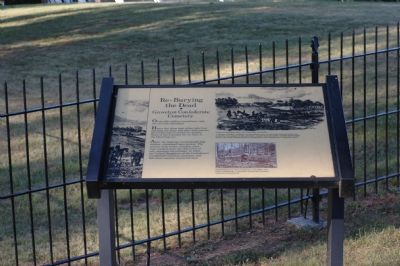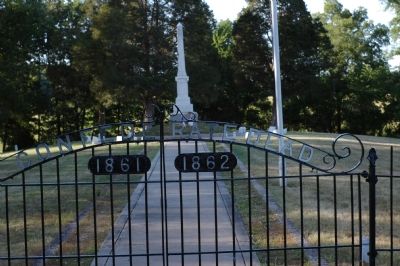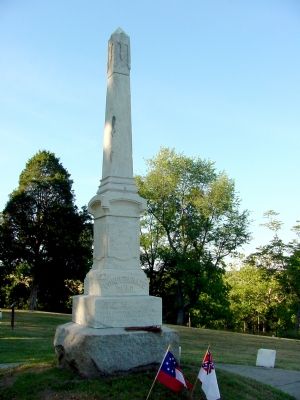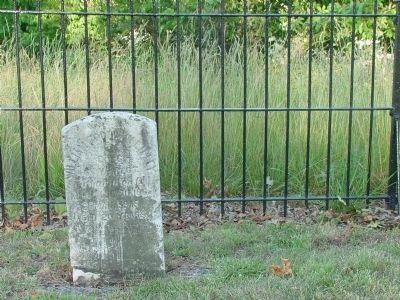Near Manassas in Prince William County, Virginia — The American South (Mid-Atlantic)
Re-Burying the Dead
Groveton Confederate Cemetery
A “Harpers Weekly” magazine correspondent wrote: “In the long, luxuriant grass one strikes his foot against skulls and bones, mingled with the deadly missiles that brought them to the earth. Hollow skulls lie contiguous to the hemispheres of exploded shells.” • Battlefield graves were unmarked, or identified with sticks, headboards, or branches. Hundreds of soldiers received no burial at all.
Topics and series. This historical marker is listed in this topic list: War, US Civil. In addition, it is included in the United Daughters of the Confederacy series list. A significant historical year for this entry is 1866.
Location. This marker has been replaced by another marker nearby. It was located near 38° 48.823′ N, 77° 32.772′ W. Marker was near Manassas, Virginia, in Prince William County. Marker could be reached from Lee Highway (U.S. 29) east of Groveton Road / Featherbed Lane, on the right when traveling south. Touch for map. Marker was at or near this postal address: 11750 Lee Highway, Manassas VA 20109, United States of America. Touch for directions.
Other nearby markers. At least 5 other markers are within walking distance of this location. Groveton Confederate Cemetery (here, next to this marker); Monument To The Confederate Dead (within shouting distance of this marker); Manassas National Battlefield Park (within shouting distance of this marker); a different marker also named Groveton Confederate Cemetery (within shouting distance of this marker); Federal Artillery Position (within shouting distance of this marker). Touch for a list and map of all markers in Manassas.
More about this marker. Groveton Cemetery is shown on U.S. 211 (an east-west route) in earlier 20th century maps. That route shared its roadway with U.S. 29 (a north-south route)at this point until it was cut back to Warrenton in the 1970's. A large parking lot provides plenty of free parking, but each person visiting must have paid the $3 National Park fee and produce the receipt on request.
This marker was replaced by one named "Groveton Confederate Cemetery." See nearby markers.
Regarding Re-Burying the Dead. Two small headstones at opposite sides of the cemetery are of the only known remains. All other soldiers buried here are unidentified.
The cemetery is situated on a gently humped hillock overlooking the road to the south and a stream north and east, and bounded by a low wrought-iron fence. A cement walkway leads from the gates to the obelisk; the central point of the cemetery. It reads:
(front face) Erected by the United Daughters of the Confederacy to the Confederate Dead. We care not whence they came, / Dear in their lifeless clay! / Whether unknown or known to fame, / Their cause and country still the same. / They died—and wore the Gray. (A stanza from the poem “March of the Deathless Dead” by Father Abram J. Ryan, Confederate Army Chaplain.)
(High on the obelisk on the front face) Dulce et decorum est pro patria mori. (A line of verse in Latin, by the Roman lyrical poet Horace, which means “It is right and proper to die for one’s country.”)
(east face) They sleep well in their unknown graves on this far-away battle field.
(north face) They gave their lives in defence of their country on the fields of the First and Second Manassas.
(west face) But for them the counting of time is not: for they dwell in the City of God.
Additional commentary.
1. March of the Deathless Dead
by Father Abram J. Ryan
(This is the entire poem, excerpted from the book Father Ryan’s Poems by Abram J. Ryan, first published in 1880.)
Gather the sacred dust
Of the warriors tried and true,
Who bore the flag of a Nation’s trust
And fell in a cause, though lost, still just,
And died for me and you.
Gather them one and all,
From the private to the chief;
Come they from hovel or princely hall,
They fell for us, and for
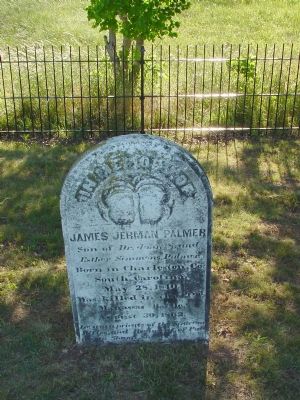
Photographed By J. J. Prats, June 10, 2006
4. In Memory of James Jerman Palmer
Son of Dr. John S. and Esther Simmons Palmer. Born in Charleston Co. South Carolina May 28, 1840. Was killed in the 2nd Manassas Battle, August 30, 1862. He was a private of the Spartan Rifles and Regiment of Palmetto Sharp Shooters. This gravestone is against the western fence near the obelisk.
The tears of a Nation’s grief.
Gather the corpses strewn
O’er many a battle plain;
From many a grave that lies so lone,
Without a name and without a stone,
Gather the Southern slain.
We care not whence they came,
Dear in their lifeless clay!
Whether unknown, or known to fame,
Their cause and country still the same;
They died—and wore the Gray.
Wherever the brave have died,
They should not rest apart;
Living, they struggled side by side,
Why should the hand of Death divide
A single heart from heart?
Gather their scattered clay,
Wherever it may rest;
Just as they marched to the bloody fray,
Just as they fell on the battle day,
Bury them, breast to breast.
The foeman need not dread
This gathering of the brave;
Without sword or flag, and with soundless tread,
We muster once more our deathless dead,
Out of each lonely grave.
The foeman need not frown,
They all are powerless now;
We gather them here and we lay them down,
And tears and prayers are the only crown
We bring to
wreathe each brow.
And the dead thus meet the dead,
While the living o’er them weep;
And the men by Lee and Stonewall led,
And the hearts that once together bled,
Together still shall sleep.
— Submitted June 24, 2006, by J. J. Prats of Powell, Ohio.
Credits. This page was last revised on July 14, 2019. It was originally submitted on June 24, 2006, by Tom Fuchs of Greenbelt, Maryland. This page has been viewed 2,776 times since then and 27 times this year. Photos: 1, 2. submitted on June 24, 2006, by J. J. Prats of Powell, Ohio. 3, 4, 5. submitted on June 24, 2006, by Tom Fuchs of Greenbelt, Maryland. • J. J. Prats was the editor who published this page.
